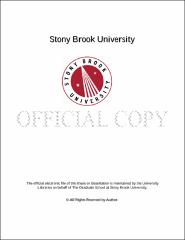| dc.identifier.uri | http://hdl.handle.net/11401/77797 | |
| dc.description.sponsorship | This work is sponsored by the Stony Brook University Graduate School in compliance with the requirements for completion of degree. | en_US |
| dc.format | Monograph | |
| dc.format.medium | Electronic Resource | en_US |
| dc.language.iso | en_US | |
| dc.publisher | The Graduate School, Stony Brook University: Stony Brook, NY. | |
| dc.type | Dissertation | |
| dcterms.abstract | The Atlantic sturgeon, Acipenser oxyrinchus, an anadromous long-lived fish has experienced substantial population declines leading to its recent listing under the Endangered Species Act. While this fish occupies and requires both riverine and marine habitats, a lack of knowledge regarding marine distribution/habitat use is hindering conservation measures directed at restoring depleted populations. Currently, concerns exist that Atlantic sturgeon populations are being hindered by incidental captures along their migrations routes within the near shore coastal fisheries. In order to best manage human activities in a way that populations may recover fully, it is necessary to understand the association between Atlantic sturgeon and their marine habitat. To address this data gap, I analyzed fishery independent bottom trawl data and classified marine habitat preference for shallow migratory pathways as well as identified large coastal aggregation areas. Using genetic and non-lethal aging techniques I was able to evaluate the population demographics of these coastal aggregations to determine they largely consist of immature juveniles belonging to the Hudson River population. Furthermore, to better understand the temporal and spatial patterns of their movements and aggregations, I acoustically tagged a large number of animals (n=429) and established a large telemetry array within the New York Bight. Results indicate repeated and consistent yearly spatial and temporal movements and habitat use. Through acoustic telemetry data, I was able to evaluate management alternatives by estimating population proportions that can be protected under a number of spatial and temporal closure scenarios. Protection under the most conservative and restrictive scenarios indicates substantial closure windows would be required to protect sturgeon migrating through this area. This study provides a substantial increase in our knowledge of Atlantic sturgeon in the marine habitat and has delineated the aggregatory behavior, population structure, habitat use, and fine scale marine migrations of this species, which have been previously unknown, and should provide management agencies with necessary data to inform decisions to increase conservation efforts for this protected species. | |
| dcterms.available | 2017-09-20T16:53:37Z | |
| dcterms.contributor | Frisk, Michael G | en_US |
| dcterms.contributor | Chapman, Demian | en_US |
| dcterms.contributor | Conover, David | en_US |
| dcterms.contributor | Pikitch, Ellen | en_US |
| dcterms.contributor | Fox, Dewayne. | en_US |
| dcterms.creator | Dunton, Keith Joseph | |
| dcterms.dateAccepted | 2017-09-20T16:53:37Z | |
| dcterms.dateSubmitted | 2017-09-20T16:53:37Z | |
| dcterms.description | Department of Marine and Atmospheric Science. | en_US |
| dcterms.extent | 233 pg. | en_US |
| dcterms.format | Monograph | |
| dcterms.format | Application/PDF | en_US |
| dcterms.identifier | http://hdl.handle.net/11401/77797 | |
| dcterms.issued | 2014-12-01 | |
| dcterms.language | en_US | |
| dcterms.provenance | Made available in DSpace on 2017-09-20T16:53:37Z (GMT). No. of bitstreams: 1
Dunton_grad.sunysb_0771E_11971.pdf: 10476134 bytes, checksum: a8cd91c01129ad76ed11406942f777df (MD5)
Previous issue date: 1 | en |
| dcterms.publisher | The Graduate School, Stony Brook University: Stony Brook, NY. | |
| dcterms.subject | age structure, anadromous, Atlantic sturgeon, conservation genetics, habitat, migration | |
| dcterms.subject | Fisheries and aquatic sciences | |
| dcterms.title | Population dynamics of juvenile Atlantic Sturgeon, Acipenser oxyrinchus oxyrinchus, within the Northwest Atlantic Ocean | |
| dcterms.type | Dissertation | |

